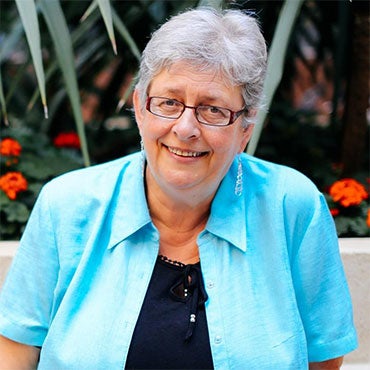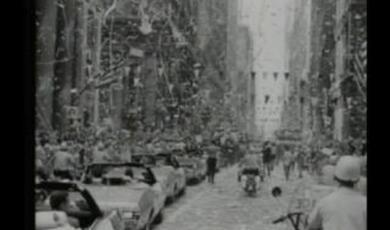Oil on Troubled Waters: The Industrial Legacy and Britain's Groundwater
Share
- Details
- Transcript
- Audio
- Downloads
- Extra Reading
Groundwater is an important source of drinking water in London and elsewhere, but the legacy of the UK's industrial revolution includes contamination at an extreme and increasingly widely-realised scale.
Drawing on research in the English Midlands, the lecture will explore how mining, metal-based manufacturing, and the oil industry have produced an environmental conundrum that is very complex to solve. How can sites that are part of our industrial heritage be prevented from polluting rivers, and poisoning local residents? Who is responsible, and how can the 'clean-up' be tackled?
Download Transcript
11 February 2016
Oil on Troubled Waters:
The Industrial Legacy and Britain's Groundwater
Professor Carolyn Roberts
Good evening ladies and gentlemen. This evening I want to talk to you about a hidden set of problems with Britain's waters. It is the problem of contaminated groundwater - that part of the water environment that we do not normally see until it is pumped up and emerges though our taps, or occasionally, in prolonged wet periods, up through our floors. It is normally out of sight, and out of mind, we might say, and until the recent debates about fracking for shale gas and the possibility of groundwater contamination arising from that, had not been uppermost in most people's minds, least of all our politicians. Before getting into the talk, I will just share with you an amusing little snippet of film about the reception given to one of the UK's politicians, Lord Browne, when he tried to talk about fracking and groundwater contamination. Terribly polite and English, I think.
I do want to talk about the types of groundwater problems that we know about already, and how they have come about. But I also want to reflect on whether these are real, genuine problems, or whether they are the result of some overly-hysterical response to contaminants that might be present naturally, from substances that are not in any case harmful, or perhaps only at homeopathic levels of concentration. By 'homeopathic concentrations', I mean the equivalent of individual molecules in billions of cubic metres of water.
More of that later.
There are, of course, some major problems of elements dissolved in groundwater that have been of major health concern. There is a very distressing story, for instance, about groundwater containing high levels of arsenic in Bangladesh. Bangladesh is not an area that we would normally associate with water shortages, being low lying and frequently flooding, but actually there are shortages of good quality drinking water and many of the population are reliant on some 10 million tube wells. These simple wells puncture the fine sediments making up the delta of the mighty Ganges/Meghna/Brahmaputrae River, which were once (and continue to be) washed down in the river from the Himalayas. Probably 35 million people, especially in the south of the country where the deltaic newer sediments lie, are exposed to levels of arsenic greater than 50 μg l-1 in their drinking water. Many wells also have high levels of manganese, which is toxic too. The sources of this contamination are not well understood, and theories vary from it being derived from Himalayan sediments washed downstream when they were first covered by newer deposits, hundreds of thousands of years ago, to it being the result of fluctuating groundwater and oxygen levels partly associated with the pumping of the water itself. The patterns are complex at local levels, with one tube well being affected and another very close by, not.
Two things are not disputed, however. Firstly, high levels of arsenic ingestion in drinking water are associated with serious and chronic damage to human health, including ghastly skin lesions (cancers), internal cancers, and non-carcinogenic effects such as diabetes, nerve damage, and cardiovascular diseases. Arsenic is cumulative. Bangladeshi people are therefore faced with a truly 'wicked' dilemma – to die of arsenic poisoning by drinking from tube wells, or to die of diarrhoea from water-borne bacterial diseases after drinking river water. We should not forget that as we consider potential sources of contamination in the UK. Secondly, responsibilities in relation to groundwater are very difficult to establish. Research undertaken on groundwater in central and north-eastern Bangladesh in 1992 by the British Geological Survey as part of a project on irrigation was used as the basis for installing many of these tube wells. The work was in part intended to be charitable. Subsequently a legal case alleging negligence was brought against BGS in a British court, but it was dismissed in 2004 on the basis that the BGS had no responsibility to flag up arsenic levels as this had not formed part of their investigation, and they had no explicit duty of care to Bangladeshi residents. Now this may or not be just, but it is but one illustration of the complexities of establishing legal responsibilities for groundwater.
Britain was the home of the first (probably) industrial revolution – the previous one, not the one that today is creating new industries from electronics, digital media, and information, rather than more material things. British cities in the past were dirty places, where life was often nasty, brutish and short. Pollution was an inevitable partner to the growth of industries, houses and transport systems. Most people in the Gresham audience here and online will be familiar with the 'Great Stink' in the Thames in the later nineteenth century, created because of a complete lack of sanitation in the city, with sewage and all sorts of organic and inorganic wastes (think slaughterhouses, tanneries, cloth manufacture) percolating into the ground, and into small sewers that discharged directly into the river. The river became so polluted with sewage that it was almost biologically dead – rather like the main river in Dhaka, Bangladesh today, in fact – a rather oily, green-black flow in which a few larger organisms attempt to survive. It caused Parliament to close down, which motivated politicians to take action.
Industrial pollution is probably less well understood. Some of the best descriptions of the nineteenth century chemical processes come from novelists such as Dickens: as a boy he worked in Warren's blacking factory, which greatly influenced his subsequent attitudes to poor Londoners (less so to women, I think, who have a notably poorer deal in his stories). 'Blacking' is the polish that is used on boots, and the 11-year old Dickens was putting this into bottles and pasting labels onto them. Blacking is a mixture of waxes and 'lamp black', or carbon black made from charred organic materials, and contains trace substances such as carboxylic, quinonic, lactonic and phenolic complexes. These substances are referred to as 'volatiles', and I will return to them later. They are certainly carcinogenic to animals, although the position is less certain for humans. It was fortunate that Dickens' nasty and brutish employment at the factory was relatively brief; else later generations might have been robbed of a great storyteller. Naturally, when industrial activity takes place there are spillages, deliberate or otherwise, of fluids that seep into the ground. Dicken's blacking spills were probably accidental, whereas well into my lifetime it was common for workmen to stove in the bases of redundant town gas tanks, and to release the tarry residues directly into the ground. What else would you do with it? Unlike organic mixtures such as sewage that will recycle or break down relatively quickly (or let's hope so as this cartoon suggests!), inorganic materials and some carbon compounds are much more resistant and can hang around for a long time in sediment or, given the right circumstances, dissolve in groundwater.
Nor are cities the only places that generate industrial contamination. Mining, smelting and all sorts of metal production, paint production, oil refining, all branches of the chemical industry and many other manufacturing industries that lie outside cities also generate groundwater, and dependent upon the baseline water chemistry, groundwater contamination. And it is complex and expensive to clean up, too. Good examples of where successful clean-up has been undertaken include the Olympic Park in London, and Danny Boyle's Olympic opening ceremony included representations of the industrial revolution creating contamination, and a clean-up explanation. Sometimes it can be many years before groundwater contamination comes to light, either because the water remains static, or because we simply do not monitor its chemistry.
I want very briefly to explain how water moves in the ground, and to do that I am going to show a couple of minutes of video. Here we see a perspex tank full of sand, in two sections with a partial partition down the middle. The sand represents the aquifer: the water-bearing rock, through which water can move, as if through a sponge. Water flows through the aquifer because the height of the water surface (the water table, or piezometric surface) in one place is higher than the other. The lab technician has put some dye onto the top of the higher place in this model, and you can see how it moves from high to low, at a rate determined by the difference in height and the nature of material: how easily it conducts the water. That property of the rock is called its hydraulic conductivity, or permeability. The curved pathways picked out by the dye are a feature of groundwater flow almost everywhere. Effectively the water is being squeezed through some places in the aquifer, which is bounded or sealed by impermeable rock, a so-called aquiclude above or below the aquifer. Clay sediments would normally be an aquiclude. Individual drops of water essentially interfere with one another as they move. The problems in modelling actual groundwater movement arise for several reasons, such as the fact that the rock structure varies from one place to another, and hence its hydraulic conductivity varies. You can see this in the sand in the tank, where tiny cracks allow water to move more quickly in some places. In the natural environment, the variability is huge; some rocks are billions of times as permeable as others. Sometimes several aquifers with different characteristics are stacked up in a 'sandwich' arrangement, the permeable bread separated by the impermeable cheese. Moreover, in reality an aquifer may be tilted or fractured, and it may be topped up by different amounts of rainfall in different places to give 'piezometric' gradients.
This tank is a two-dimensional model. When we add to this, a third dimension, the flowlines followed by groundwater become very complicated indeed. This computer model actually shows some examples of what happens when we alter the water table, the piezometric surface, by pumping water out, for example from a mine or to drink. The patterns are really contorted, and probably incorrect in detail, although in this set of simulations, rather beautiful. In practice the only way we can really understand groundwater flows in particular settings is to try to monitor what is actually happening.
Let us get back to reality. Back in the 1990s, I conducted some research on a site contaminated with industrial debris, which had had an oil terminal built on it. An oil terminal is an area where oil is stored pending collection by tankers that deliver it to service stations and garages. In this instance the site was constructed in the 1960s, when oil was delivered to it by rail from the refinery at Milford Haven. Later on this was switched to a more efficient pipeline supply, where fuel of different types (then it was leaded, unleaded and so forth) is pumped from the coast to terminals along a pipe, separated by long slugs of water; miraculously, it does not mix in the pipes. On arrival it is stored in these large tanks. The site was in the north of the Birmingham conurbation, the grey area on the map here, within the catchment area of the River Tame. The Tame was, and still is, a truly awful river, marked on the map in blue. Our area of interest tonight is the Oldbury arm or the river, arising in Birmingham itself and flowing north past the site of this oil terminal. You can see this is the headwater of the river. The geology map shows us that much of the catchment is underlain by sedimentary rocks, sands and clays, but of some importance is the grey area of the Coal Measures. This coal is the one of the key reasons why this area of the UK was the seat of the industrial revolution, and developed all sorts of metal-related industries, including cars, brass manufacture, jewellery and gunsmithing. The other is the Sherwood Sandstone, which is a major aquifer, shown in red here.
The water quality in the River Tame was classified in the 1990s as River Ecology Class 5, which is the worst grading on a scale from 1 to 5, and so bad was the situation that the plan, even after some attempts to clean it up, was for it to remain at Class 5. This map relates to complaints about water quality made in 1993. The grey areas in the circles relate to oil contamination, which you can see forms the largest proportion of the visible problem then. It was probably coming from spills and leakages from the site, and from other similar sites elsewhere in the catchment area. However there are several other sources of contamination including chemical sources, sewage and agricultural pollution – even in the centre of the city. Chlorinated solvents are another cause of concern, including those used in metal industries and dry cleaning fluids, and although I did not look at those, others have identified the presence of many different types. When I looked in more detail I found that acidic groundwater seepages from the terminal site were emerging through the river bank. They typically left behind them an ochreous, orange-coloured deposit, made up mainly of iron compounds, that blanketed the river bed.
The map of the site gives us some more indications of problems. Here you can see the clusters of circular tanks, surrounded by the River Tame on one side, and two canals on two of the other sides (the river passes under the canal), with a car park on the fourth. There is a lot of concrete. Pressed by the Environment Agency, the company had constructed a French drain alongside the river, which is essentially a gravel-filled trench intended to trap percolating groundwater. Water (and oil) was pumped out of the trench, and up to a large rectangular tank where the oil gradually floated up to the surface and was skimmed off. Interestingly, that was recycled into marine diesel. The residual water was then allowed to overflow back into the river. You can see this layout very clearly in this satellite image of 1999, after the whole thing, except for the rectangular tank, had been cleared away.
What I also knew was that the oil storage tanks had been built on top of about 10m of industrial refuse. So, when we came to monitor what was going on, things became quite exciting. In this 1945 aerial photograph, you can see metal slag debris covering the site prior to the construction of the terminal. My problem was to identify the source of the contaminated groundwater, and to work out a water management strategy for the site that would reduce the problems and satisfy the Environment Agency. I did that by instrumenting the site with rain gauges, flow monitors, water samplers, and borehole monitoring points. The illustrations show one of my research assistants, and me, sampling the river, and the groundwater. In the photograph of the groundwater sample you can see a column of water in the baler, with quite a bit of black oil floating on top of it, staining the water underneath. At one point, on one occasion, we had over a metre of floating oil sitting under the site, depressing the groundwater locally; we were sure it was a leak, although the site operators denied it. Actually, hydrological research in this environment is a huge challenge because of the risk of explosions; everything has to be 'intrinsically safe'. And the working environment is not particularly pleasant. We collected about twelve months' worth of data, analysing hundreds if not thousands of samples from various points around the site; unfortunately it was a pretty wet year. I also had an unfortunate drenching when I slipped into the river when sampling, by myself, on New Years' Day 1996, and had quite a struggle to get out (reluctant to abandon the water samples I had taken). I cannot go through all the analyses we did, assisted by a student from Coventry University, but one of the more startling findings was that the water from the French drain, when sampled and exposed to air for a few minutes, had iron and manganese compounds visibly precipitating out. It was very acidic.
These maps show what happened with the levels of groundwater under the site, as recorded in our boreholes. The first shows the groundwater levels early in 1997, with the surface falling away by some three or so metres towards the river – so groundwater is seeping from somewhere though the site, from east to west into the river. By April, following a wet spring, you can see a bulge in the groundwater surface, testifying to water entering from the east and moving more rapidly westwards, taking dissolved materials from the industrial waste with it, into the river. By June, the bulge was further into the site, again water moving from beyond the site margins into and under it, and thence into the French drain. At this point the site managers attempted to build other structures to catch the contaminated water, using a plate separator and dosing it with herbicide to keep it clear of the algae that continually grew on the plates. However, they had seriously underestimated the volumes of water requiring to be treated in this way, and began running up a monthly bill of thousands of pounds on the chemical treatment and disposal costs alone.
In terms of the quality of water, we also discovered that under the centre of the site, the water was very saline, with high concentrations of chloride, in a localised plume. That appeared to fall away around that point. There were all sorts of other contaminants in the ground water too, not only the oil, the iron and the manganese, but a range of volatile oil-derived substances, arsenic, chromium and other legacies of the Industrial Revolution, plus ammonium, nitrates and phosphates. Some of these were chemical breakdown products from the oil, but every time it rained, these toxic substances were pushed by the rainfall and by localised flows of groundwater, across the site and into the river. This is why the river was essentially dead. Hundreds of similar sites behave in the same way.
However, our historical researches also paid some dividends. You may be able to see in these maps that at the end of the nineteenth century, the area had a coal mine in it, and a branch of the canal now disappeared, plus a waggon works where iron foundry work was going on. After that, the maps and the aerial photographs showed us that the point from which water was entering the site in the east was almost certainly the point at which the former canal branch had been located, and the point at which the salt was entering appeared to be rising groundwater coming from the former mine shaft. All in all, pretty difficult to manage.
Towards the end of the research programme, we did have a great deal of fun attempting to measure the hydraulic conductivity of the 10 metre sandwich of industrial refuse on which the terminal had been built. Normally, this is done by pumping water from a borehole and recording the level to which the water level falls in a circular area around the hole, the drawdown. Our problem was that the groundwater was so contaminated that we would have had a huge bill for disposal and treatment of it, so instead we used the firefighting hoses to pump water into various boreholes and then recorded the rate at which the level fell in the hole after we had stopped. Suffice it to say that everyone ended up drenched. But the investigations showed that instead of only passing through the matrix of the material, like a sponge, there were open voids and passages in it that allowed some water to pour through the site.
The research almost finished, late in 1997 the company was acquired by Shell, and we had an embargo on publication of our results, largely because the value of the land would be compromised. Despite this, as you can see by 2014, the land had been sold, terminal structures removed, some attempt at clean up made, and a set of warehouses has been constructed on the site. It still looks pretty awful, actually, and the beneficial impact on the river has been slight.
Before we speculate about the responsibilities here, I would like to touch on a few other examples of groundwater contamination of different sorts, in different settings. Oil is essentially a natural product, albeit present in unduly high concentrations. It is less dense than water and floats on top of it, with small elements dissolving into the underlying water, and some breakdown by microorganisms if time allows. Some of it also disperses into the air, and some adsorbs onto sediment particles. Other volatile materials may be artificially produced, and have different characteristics; I will not expose you to the delights of organic and inorganic chemistry.
Some substances appear at enhanced levels in urban groundwater because of sewer leakages, including nitrates, ammonia, and sulphates and chloride from road de-icing, but the commonest industrial groundwater contaminant is trichloroethene (TCE), a solvent used for a long time in the metal industry, but also found in paint remover, adhesive and typewriter correction fluid. It is spreading and breakdown in the groundwater zone has been the subject of many studies. Under favorable microbial and chemical conditions, TCE concentrations have been observed to decline quickly from high levels to levels that are within legal limits, which is obviously desirable if people are going to drink the water. On the other hand, TCE can be conserved, that is, remain unchanged, in plumes that extend perhaps a kilometre from a spill or discharge. The map shows a former factory in Connecticut, with a persistent volatile organic compound plume extending 700 m from the source to a river, running along on top of the aquitard, below the groundwater but decaying into it. Maximum TCE concentrations along a transect 280 m from the source were in the 1000s of μg/L with minimal degradation products. It is thought to be carcinogenic. TCE is linked with a range of health problems. It is an irritant, but in cases of chronic consumption, is thought to lead to liver and kidney complaints. It is almost certainly in London's groundwater
Other volatile organic compounds include tetrachloroethene (PCE or 'Perc' dry cleaning fluid) a chlorine compound which again has been shown to travel considerable distances, maybe a couple of hundred metres through sandy sediments before it starts to degrade. The diagram shows observations taken in Ontario where it seeps upwards into river beds. 'Perc' is also a dense fluid and like TCE generally sinks down through groundwater, in contrast to oil which floats.
What do we learn from this? I am left with many questions, even beyond the basic complexity of tracking and modelling groundwater flow patterns. For instance, wherever we look, we find volatile organic compounds of various types. Historic data from 1987 (as Ellis says, in a study that was the first to focus at city scale) indicated that TCE occurred in almost 80% of the wells in Birmingham, with maximum concentrations to over 5000 μ g/l in the Tame valley. More detailed recent analysis shows the concentrations for TCE and TCA. The Sherwood Sandstone aquifer was, and is a major source of water. Removing these substances from drinking water is very expensive. We also know that substances such as lead are widespread in London sediments and a range of toxic metals have been found even in parkland soils in cities, as shown on the diagram. Almost wherever we look, we find a potentially toxic cocktail. And beyond that, our laboratory capability to analyse for these substances is improving all the time, so not only are we looking at more sites, we are also able to find substances such as the contraceptive pill at lower concentrations than ever before.
Another question is the availability of data. No-one wants to admit to having contaminated groundwater under their property, so a great deal of information is hidden and only discovered by indirect means. We do know that there are hot spots of different contaminants such as lead, and the map shows London, but there will be thousands of others, as yet unknown.
Thirdly, in many cities, there is concern that contaminated groundwater will get into drinking water supplies or ecological systems. The literature indicates that many thousands of wells in the UK have been affected by industrial volatile organic contaminants (VOCs) such as TCE, for example. More recently we have discovered far more about the impacts of endocrine disruptors, pharmaceuticals found in groundwater leaking from sewers, and we are now looking for them and finding them. On the positive side, we are using less groundwater for drinking than we did in the earlier part of the twentieth century. On the negative side, we are running out of water resources and will have to look at urban groundwater sources again soon.
In truth, in the UK there are very few documented examples of contaminated groundwater causing injury or death, and whilst some of these substances are so toxic that micrograms per litre are appropriate limits, in many cases we do not know whether there are pathways for these substances to be ingested or what the health result of prolonged consumption would be – the appalling Bangladesh 'experiment' is an unusual one. In the UK we do have a relatively rigorous regime for checking drinking water, and those people who switch to bottled water, apparently for health benefits, are fooling themselves because the requirements are less rigorous. Moreover bottled water drinkers risk ingesting substances leached from the plastic bottles such as bisphenol A, linked to early puberty and prostate cancer, or even the apparently safer bisphenol S which is now replacing it in the plastic.
We can clean up such 'brown field sites' for particular uses, but there is a price to be paid. The risk needs to be balanced against pragmatism. The intended land use determines the defining limit for particular contaminants in the sediment, but not the groundwater as that is too variable at any one time, and in any case is mobile. We see this in the UK legislation, such as the Environmental Protection Act, where you will also see the difficult word 'significant' used a lot. If we plan to use the land for industry, for instance as happened at the Gulf Oil terminal site, the required levels for particular substances are higher, more lenient, but that has consequences for the future. Even so, owners may not be prepared, or indeed able, to pay the costs, even though the risk affects all of us. Gulf Oil UK for example, bought their site in good faith in the 1960s when scientific knowledge was less complete, and developed a facility on it – the type of facility upon which we all depend if we drive a car. They grappled with the contaminated water, although as it transpired most of it was not generated on their site, and although they spilled some oil, most of the groundwater contamination was probably coming from historic waste materials – an Anthropocene deposit as these are now being titled. Gulf Oil UK ended up insolvent (not as a direct result of this) but it cost them hundreds of thousands of pounds to try to sort it out. I would argue that they were not negligent. So, was the nuisance to down-gradient users of groundwater, actually their moral or legal responsibility at all?
I will leave the last word to the Royal Commission on Environmental Pollution, some years ago but reflecting an almost unchanged situation. They were 'not aware of any study that provided firm evidence of adverse effects of contaminated land on health'. Are you convinced we know enough?
© Professor Carolyn Roberts, 2016
Part of:
This event was on Thu, 11 Feb 2016
Support Gresham
Gresham College has offered an outstanding education to the public free of charge for over 400 years. Today, Gresham plays an important role in fostering a love of learning and a greater understanding of ourselves and the world around us. Your donation will help to widen our reach and to broaden our audience, allowing more people to benefit from a high-quality education from some of the brightest minds.


 Login
Login







